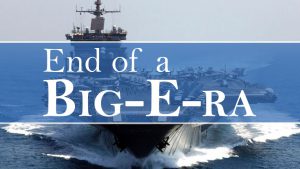The End of A Big-E-ra, the USS Enterprise Decommissioned

While the process of defueling and later scrapping of the Enterprise is underway, a next generation Big-E will take its place in a few years.
The ship is remembered for playing a critical role in the Cuban Missile Crisis, Vietnam and the wars in Iraq and Afghanistan.
And apart from the history of the ship, the name Enterprise evokes a great deal of passion for members of the U.S. Navy and many Americans.
The first USS Enterprise (CV-6) was instrumental in the Pacific theater during World War II, engaged in the battle of Midway, amphibious assaults throughout the south Pacific, and the battles of the Philippine Sea and Leyte Gulf.
Following the war, the USS Enterprise participated in Operation Magic Carpet, where it sailed across the Atlantic to bring servicemen home from Europe.
Soon after the USS Enterprise was decommissioned, the latest USS Enterprise (CVN-65) was launched in 1960, and served for over 50 years.
The new USS Enterprise (CVN-80) will be the third Gerald R. Ford-class aircraft carrier and is expected to be complete and in operation by 2027. It will not be as long as its predecessor, but it will be able to hold more aircraft. This is due in large part, because its use of modern technology will make it easier for fewer sailors to operate and manage the ship.
In reviewing the history of the Enterprise, one can see how as time has gone, the size and capability of our aircraft carriers has changed dramatically.
CV-6 was a little over 820 feet long. CVN-65 was 1,123 feet, and is to this day the longest naval vessel ever built.
CV-6 had a maximum capacity for 2,217 sailors. CVN-65 can hold 5,828.
Of course, with the increase in size and equipment, the number of parts needed to maintain the last Enterprise increased significantly as well. We fully anticipate that when CVN-80 launches in several years, the part needs will still be substantial, but likely the number of digital / electronic parts will increase.
Overall, the cost of new carriers is 4 times what the last Enterprise cost (comparing the two in 2017 dollars). And when you calculate in the “costs of the air wing, the support of five surface-combat ships and one attack submarine, and 6,700 sailors,” as George Will notes, the daily operating cost of these carrier strike groups is between $2.5 million and $3 million a day.
Given the budget realities we are faced with, as well as the changing dynamics around the world, and changes in technology and war-fighting, it seems likely that we may never see a ship as large as the Big E in our lifetimes. Modern ships are becoming lighter, sleeker, and designed for stealth. With the decommissioning of the Enterprise, we truly have likely seen the end of a Big E-ra.

